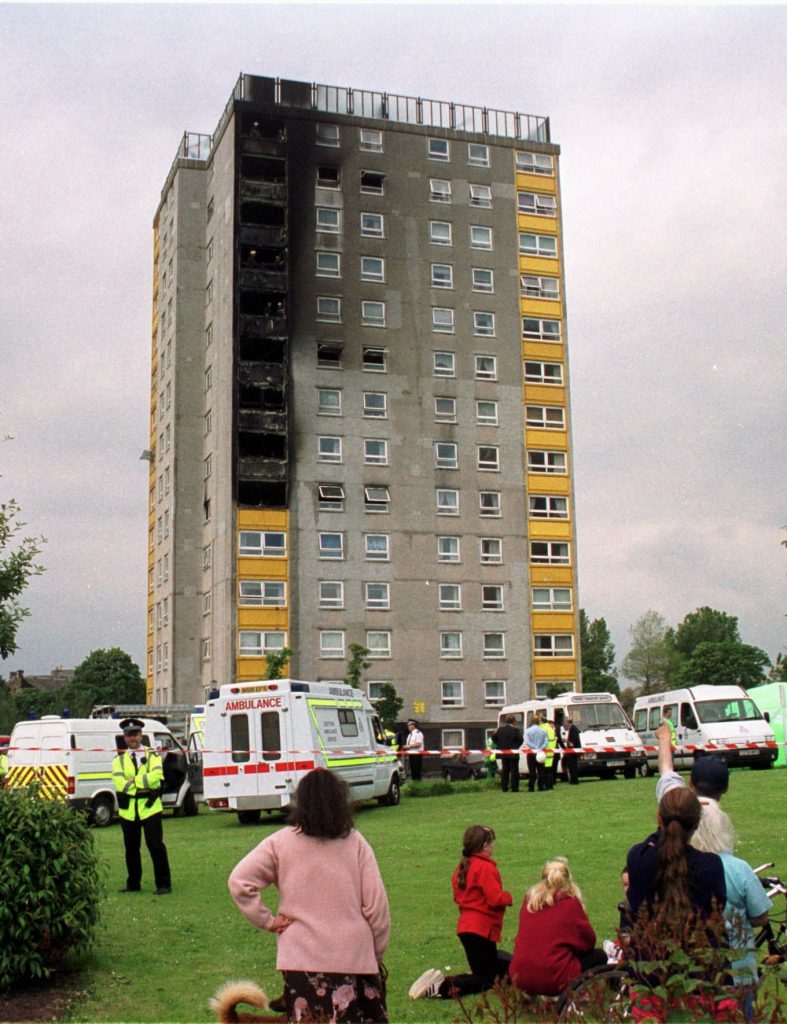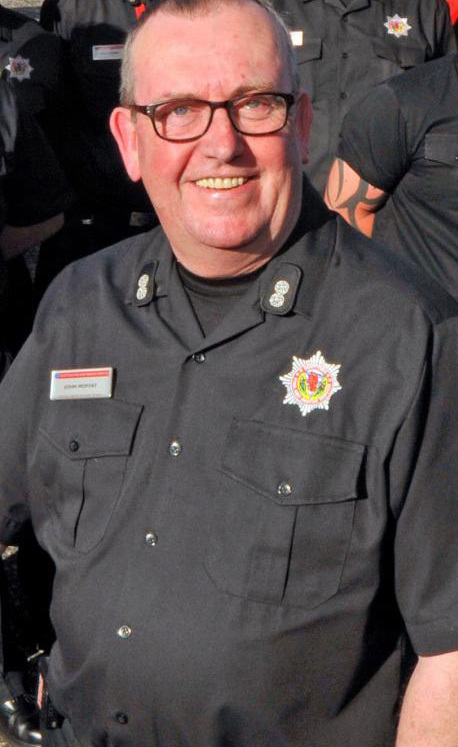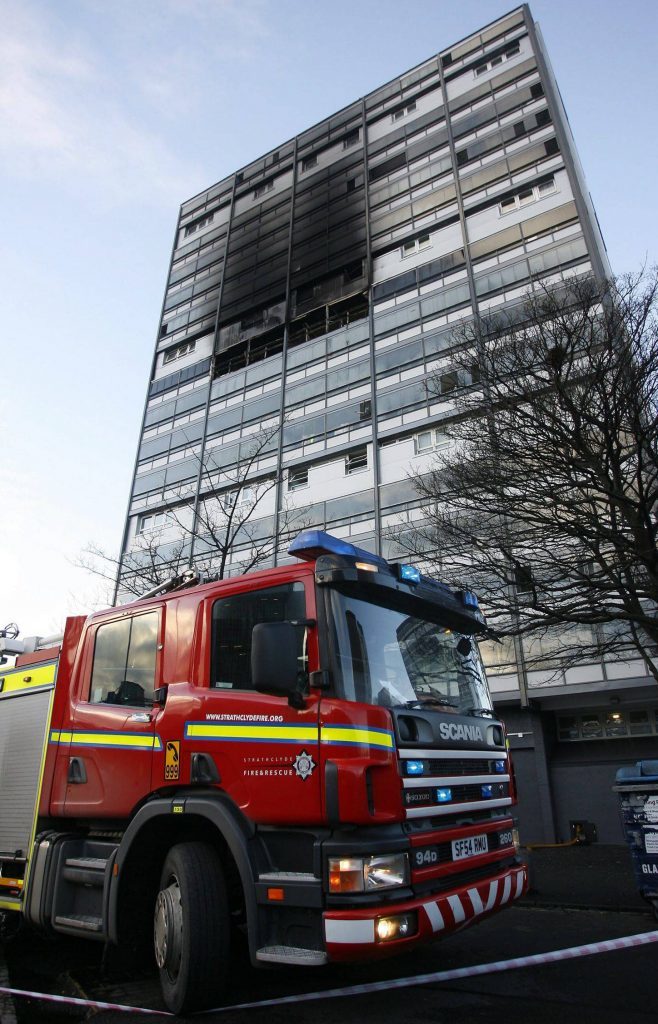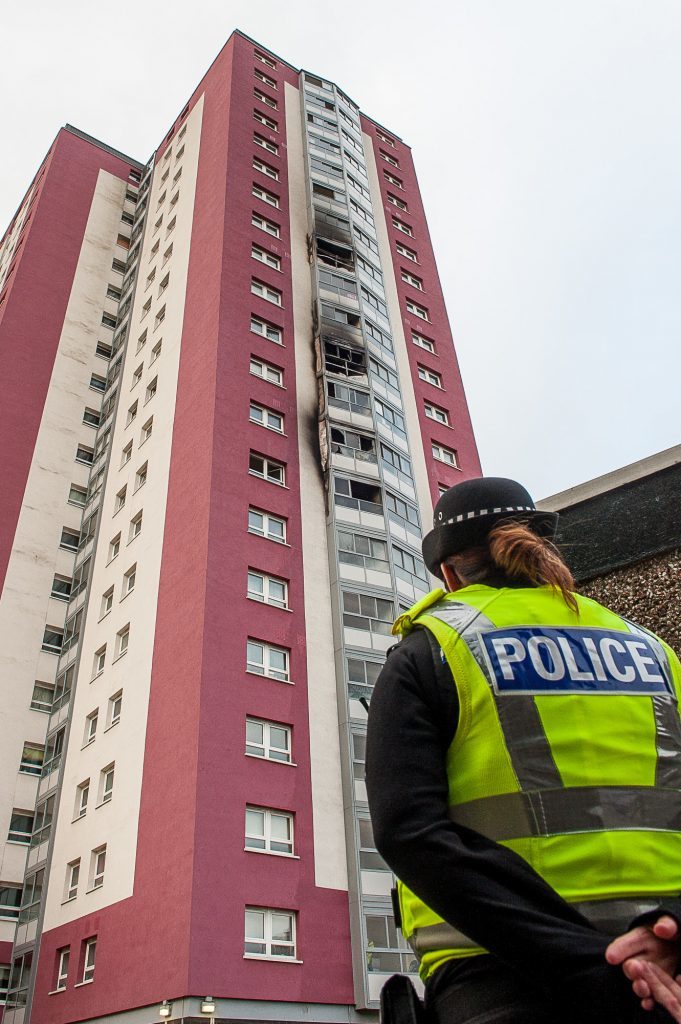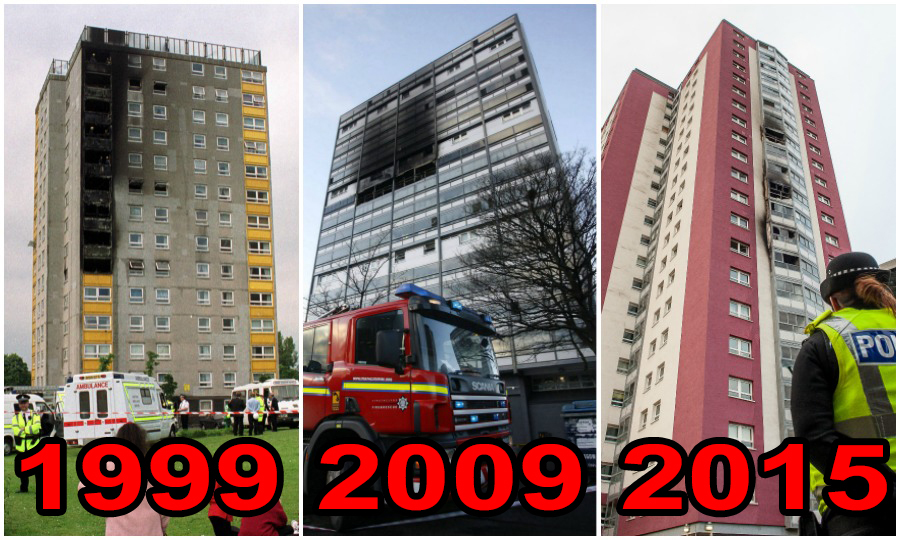
IT was the tower block tragedy that was supposed to change everything.
In 1999, external cladding was blamed when a fire at Garnock Court in Irvine spread to other floors. A committee of MPs probed the blaze and set down new safety standards.
But fires in tower blocks have continued – sometimes spreading from floor to floor. In the wake of last week’s tragedy in London, Scottish high-rise residents have expressed increasing concern about the safety of their homes.
Here we examine the history of Scotland’s high-rises, looking at the Irvine fire and two more recent cases, the questions they raised and the human cost that followed from them.
1999: Firefighters dodged falling debris in fire which claimed life of disabled man
IT was the high-rise fire which first raised concerns over cladding on tower blocks.
One man died and five people, including a 15-month-old child, had to be rescued by firemen after a blaze tore through nine floors at Garnock Court in Irvine.
Witnesses told how the flames leapt up yellow-coloured cladding on the corners of the block, taking just five minutes to spread.
The 1999 blaze prompted a Parliamenary inquiry into tower block cladding, which recommended a much tougher testing regime and the use of non-combustible materials.
Last night the fire brigade Watch Manager who battled the blaze in the 14-storey block said it was the worst he ever encountered.
Class divide in fire safety laws as some Scots tenants aren’t guaranteed a working smoke alarm – click here to read more
John Moffat, now 55 and retired, remembers the blaze to this day.
“It’s one of the worst fires I ever dealt with. We had to go up to the 12th floor to deal with it. It was really scary.
“We could see the blaze from Troon.
“There were 15 or 20 fire engines and there were aerial platforms that rescued people from different floors.
“There were parts of the cladding dropping on to the first appliance that could not be moved as it was supplying the firefighters with water.
“The fire spread very quickly. It was a significant fire.
“It was very frightening and that was small-scale compared to what happened in London.”
John said the Irvine blaze went from about the third or fourth floor up to the 12th.
He and his colleagues were inside the block tackling the blaze on the 12th floor as it continued to burn on the outside of the building below.
John said he and a group of colleagues were tasked with firefighting while another group searched the building to get people out.
He said: “It was very arduous and tiring. We were carrying hoses up manually because we couldn’t use the lifts.
“We had to dodge falling debris on the way in and out of the building.”
One resident, disabled Alexander Linton, aged 55, died in the blaze.
The fire prompted Westminster’s environment, transport and regional affairs committee to carry out an inquiry in 2000.
The committee looked into the potential risk of fire spread in buildings through external cladding systems, calling 14 witnesses.
Its final report concluded: “We do not believe it should take a serious fire in which many people are killed before all reasonable steps are taken towards minimising the risks.
“All external cladding systems should be required either to be entirely non-combustible or to be proven through full-scale testing not to pose an unacceptable level of risk in terms of fire spread.”
John said the fire was similar to London in as much as it was a tower block blaze that spread from floor to floor.
However, he said the Irvine fire was “nowhere near” the severity of the devastating London incident.
He said: “London reminded me of the fire in Irvine but not to the same extent.
“The firefighters in London must have gone through so much more than we did.
A North Ayrshire Council spokesperson said: “we would like to reassure residents that health and safety is an absolute priority for the Council.
“The Scottish Fire and Rescue Service conduct quarterly inspections of all our residential high rise buildings, in addition to our own maintenance and inspection regimes. Residents are also encouraged to contact the Scottish Fire and Rescue Service to arrange a free home fire safety visit.
“A North Ayrshire Council tenant sadly died in a house fire in one of our high-rise flats in 1999.
“The decision to replace the in-fill panels was taken immediately and the works were completed shortly afterwards. Investigations following the event were instrumental in bringing about a change in the regulations.”
Former Strathclyde Fire chief Brian Sweeney calls for councils to install sprinklers in all flat blocks after Grenfell disaster – click here to read more
2009: ‘Go and save your lives’… dad’s dying words to heartbroken Annette
THE Grenfell tragedy brought back terrible memories for Annette Smith.
Her father died after a blaze in his multi-storey flat – despite her attempts to save him. Thomas Smith, 61, was trapped in a fierce fire in his flat in Glasgow’s Gorbals in 2009.
Speaking from her ground floor flat in Cranhill in the north-east of the city, Annette, 33, said: “My heart goes out to the families in London.
“As I watched the fire unfold on TV last week I had to turn away because it brought back terrifying memories of trying to save my dad. I know what the families are going through and want to send them my sincere condolences.”
Recalling the tragedy eight years ago, Annette said she and her partner found her dad conscious but unable to move.
She added: “The fire in our Waddell Court home spread so fast dad stood no chance.
“He just kept staring into space as though the smoke had confused him.
“My partner and I tried to move him but couldn’t.
“Dad just managed to say, ‘Go and save your lives.’
“I now live in a ground floor flat because I can not bear to stay any higher.
“I never want ever to struggle in smoke wondering how to escape from a high-rise fire.
“It is terrifying because every choking breath feels like your last. Even after years of trying to recover emotionally I still suffer from the memories of the fire.”
She and her partner were rehoused in a temporary flat where she could see the burned remnants of the fire scene.
“I pleaded to be placed in a house anywhere else in the city,” she said.
“I couldn’t bear to see where dad died. We can only hope that the London families are treated with more compassion than I was.”
At the time, Area Commander Garry Milne – one of the officers in charge during the incident – said: “In my 20-plus years in the fire service I have never seen such a fierce fire.
“Our firefighters were magnificent in the way that they fought their way through intense heat and smoke to tackle the blaze.”
Neighbours confused by the smoke had to be given breathing masks by firefighters leading them to safety. Now, as investigations into the Grenfell Tower fire begin, many living in tower blocks wonder how safe they really are.
“Lessons have to be learned because people matter,” said Annette.
“Losing a loved one is incredibly painful and it cannot go on.”
Waddell Court tenant Lynsey Nixon, 32, is another resident with serious safety concerns.
She said: “As the mum of two young girls I need to know I live in a safe home. I cannot understand why our flats do not have a sprinkler system installed.
“Many people around here want to know how safe they are.”
Last night, a spokesman for Glasgow Housing Association, which managed Waddell Court at the time of the fire, said: “After the fire at Waddell Court, we improved fire-stopping measures.”
Human rights campaigner Robina Qureshi says Grenfell Tower disaster demands a criminal probe – click here to read more
2015: Flames tore through eight storeys – two years after improvement works
THIS is the damage to a Glasgow high-rise block after a fire spread up through eight storeys.
The 2015 blaze came just two years after improvement works which saw balconies enclosed to make the flats warmer.
But locals feared external improvements to the tower block, in Charles Street, Springburn, left it vulnerable to fire.
Glasgow Housing Association says it carries out daily safety patrols, regular inspections and liaises closely with the fire service.
However, Alexander Reid, 51, a former industrial painter who lives in an identical tower block yards away, said: “The fire spread several storeys.
“We need to know how safe our homes are. Work was done to make the windows more fireproof but reassurances are needed.
“Everyone has watched how the Grenfell tower block went up so quickly.
“Is all cladding safe or does it provide a quick route for fire to spread? I want to move out of here. I have already spoken to Glasgow Housing Association about getting another home.”
Last night, a spokesman for Glasgow Housing Association, landlord of the Charles Street tower, said it had achieved a dramatic improvement in its properties’ fire safety thanks to a series of initiatives.
He said: “We have a very successful partnership with Scottish Fire and Rescue Service which has seen an officer seconded to work alongside our housing staff.
“We listen carefully to the advice of the fire service and take action based on their recommendations.”
After the 2015 blaze, additional fire-stopping measures were added to the multi-storeys at Charles Street following discussions with the fire service.
The spokesman added: “The materials and systems used in our multi-storey investment programme meet and in many cases exceed Scottish building standards and regulations for this type of property.
“The systems used are designed to prevent the spread of fire and they are manufactured with non-combustible materials.”
Background
THEY were seen as a quick, cheap and futuristic solution to Scotland’s housing shortage.
High-rise residential tower blocks sprang up across cities and larger towns throughout the ’60s and ’70s, changing the face of many of those conurbations and in the case of Glasgow, creating Britain’s first high-rise city.
Scotland built more tower blocks, around 1000, than anywhere in the UK, with Glasgow leading the way.
But just as Glasgow’s tenements became synonymous with slums and poverty, high-rise flats threw up as many problems as they solved.
Many were shoddily built, with residents finding them cold and damp, older people and young famiies felt stranded on the higher floors and some towers were far from local services.
By the ’80s many of the country’s high-rise estates were associated – often ufairly – with crime and social ills.
Councils faced two options – refurbish or demolish them.
Some were knocked down – most notably Glasgow’s notorious Red Road Flats, and the Bluevale and Whitevale Towers, Scotland’s tallest buildings.
Other blocks underwent extensive refurbishment, in a bid to improve their appearance with insulation and external cladding added.
It is this cladding and other external additions which are feared to have allowed a series of fires – including last week’s blaze at London’s Grenfell Tower – to spread so rapidly.
Electrical dangers
SCOTTISH crews respond, on average, to two house fires every day caused by the misuse of electrical equipment and faulty appliances.
And 1210 fires over the last five years were started by kitchen appliances alone.
The shocking figures illustrate the scale of the dangers posed by common household items.
A faulty fridge is believed to have caused the horrific blaze that ripped through Grenfell Tower.
Neighbours said a man rushed to raise the alarm as flames raged through his fourth-floor flat.
In the last five years, Scottish crews have been called to more than 3840 house fires where an electrical appliance was the source of ignition.
Kitchen appliances accounted for a third of these – with 425 sparked by washing machines, 371 by tumble dryers, 203 by dishwashers, 141 by fridge-freezers, 51 by washer-dryers and 19 by spin dryers.
The figures also show 1800 of the blazes were started by wiring, cabling and plugs.
Fire Service bosses said that while some devices such as fridge-freezers are designed to be left on at all times, most are not.
Appliances should be switched off and unplugged as part of night-time routines – or whenever people leave the house.

Enjoy the convenience of having The Sunday Post delivered as a digital ePaper straight to your smartphone, tablet or computer.
Subscribe for only £5.49 a month and enjoy all the benefits of the printed paper as a digital replica.
Subscribe